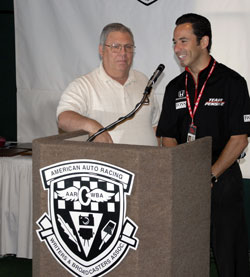 I think this is an agricultural story since this man is holding something that contains ethanol and fruit juice. That works right? One of the inventions of the Ethanol Promotion and Information Council (Joanna Schroeder) is the “e”-tini, a very colorful martini. Actually there are 3 different ones and I’ll have to update this post to provide the details on them.
I think this is an agricultural story since this man is holding something that contains ethanol and fruit juice. That works right? One of the inventions of the Ethanol Promotion and Information Council (Joanna Schroeder) is the “e”-tini, a very colorful martini. Actually there are 3 different ones and I’ll have to update this post to provide the details on them.
This is our bartender at the EPIC member reception last night who was very animated and enjoyed making a new drink. Prior to the reception we had him practice and did a little quality control to make sure they were just right.
It’s a fun idea that ties right into the whole idea of promoting a renewable fuel.

 I picked up a card while at the Alltech International Feed Industry Symposium this week and didn’t really even look at it until this morning while I was playing a little catch up here in my hotel room. It’s a direct mail piece for Alltech’s Bioplex and their podcasts! They’re producing them to target specific animal species producers and they’re called
I picked up a card while at the Alltech International Feed Industry Symposium this week and didn’t really even look at it until this morning while I was playing a little catch up here in my hotel room. It’s a direct mail piece for Alltech’s Bioplex and their podcasts! They’re producing them to target specific animal species producers and they’re called  You may remember the tragedy that occurred last year at the first IndyCar race when Paul Dana was killed in a pre-race crash. I had conducted his
You may remember the tragedy that occurred last year at the first IndyCar race when Paul Dana was killed in a pre-race crash. I had conducted his  It looks like
It looks like  I’ve been covering enough IRL races for EPIC that I decided to join the
I’ve been covering enough IRL races for EPIC that I decided to join the  The Ethanol Promotion and Information Council has been promoting the “e” as the brand for ethanol. So if you’re going to brand something you slap that baby everywhere you can.
The Ethanol Promotion and Information Council has been promoting the “e” as the brand for ethanol. So if you’re going to brand something you slap that baby everywhere you can.  It’s Miller Lite Carb day here at the
It’s Miller Lite Carb day here at the  We got to the Scott Sharp Patron party a little late yesterday but we did sample a very good margarita. I think this is a sharp looking car don’t you?
We got to the Scott Sharp Patron party a little late yesterday but we did sample a very good margarita. I think this is a sharp looking car don’t you? This year I’m renting a Nikon 80-400mm zoom lens to enhance my shooting experience. While I was practicing in turn 3 here at the Speedway I noticed
This year I’m renting a Nikon 80-400mm zoom lens to enhance my shooting experience. While I was practicing in turn 3 here at the Speedway I noticed  It’s a beautiful day here in Indianapolis as you can see from this photo I hope. Sometimes you get a nice picture at the most unexpected times.
It’s a beautiful day here in Indianapolis as you can see from this photo I hope. Sometimes you get a nice picture at the most unexpected times.